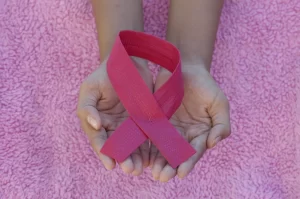By Iris Farrou
05 Oct, 2022
Breast health, Lifestyle Tips, Prevention, Queer Health, Women's Health, Young adults & teens
Best OBGYN Groups in Buffalo, Breast cancer, Breast cancer awareness, Breast cancer awareness month, Buffalo OBGYN, cancer charity, mammogram, When do I need a mammogram
October is best known as the month dedicated to spooky costumes and candy, but it is
also the month dedicated to Breast Cancer Awareness. Apart from skin cancers, breast cancer is
the most common one among American women. Facts show us that 1 in 8 women in the US will
receive a diagnosis of breast cancer in her lifetime, but the really good news is that 65% of cases
are diagnosed at a localized state–meaning that the cancer has not spread past the breast–for
which the five-year survival rate is 99%.

It is also encouraging to hear that there are over 3.8
million breast cancer survivors in the United States alone. The positive facts about breast cancer
assure us that science is working hard to enhance the survival rate for women who are diagnosed
with breast cancer, and is also making great strides to provide successful preventative
techniques.
During the month of October, there are continued efforts to fundraise money for
dedicated breast-cancer research, to support survivors, and to spread awareness and information
to younger women. If you are in Buffalo, NY you may want to consider participating in the
annual Making Strides of Buffalo walk, which is dedicated to making an impact and saving lives,
organized by Roswell Park Comprehensive Cancer Center. This year, the event takes place on
October 22nd, and you can easily sign up for the event on the American Cancer Society’s
website. The event does not have a registration fee, so it is accessible to a greater number of
people.
If you cannot attend the event in person, you can also make a donation, and keep
fundraising going by looking into the Matching Gifts programs: many employers will match
their employees’ charitable donations, or even volunteer hours, thus doubling the impact
individuals make on Breast Cancer Awareness! You can find out directly from your employer if
they are registered for a matching gifts program, or you can use the tool provided by Double the
Donation.
Another great way to support research and other initiatives toward Breast Cancer
Awareness is to create your own fundraising events; many tech-savvy folks set up their own
fundraising pages, or they simply ask their loved ones to collect donations towards this cause in
lieu of birthday, wedding, or anniversary gifts. If you have an online presence, you can easily
bring people together through Facebook or Instagram Live, and even Zoom, to provide support,
share knowledge, and build a community.
Breast Cancer Awareness Month
Fundraising for Breast Cancer: 8 Breast Cancer Awareness Month Ideas to Make an Impact
More

Though the word “mammogram” may ring as scary for many women, it is essentially an X-ray imaging of your breasts to detect a tumor or other abnormalities. There is no suggested or ideal age at which medical professionals agree one should start getting a screening mammogram, but typically women get their first mammogram between ages 35 and 40. Depending on risk level and preferences, women should discuss the options and risks with their doctor.
Remember that getting a screening mammogram does not necessarily mean there is cancer present: even if you get a call back, which is most common in first mammograms, it is most likely to look at a certain area more carefully. An extra ultrasound may be more commonly required in women who are pre-menopausal and get a mammogram done.
Facility Tips
- Choose a facility that specializes in mammograms and conducts a number of them in a day, speaking to its credibility and expertise. To reassure yourself about the standards being met, you may request to see an FDA certificate. If possible, visit the same facility every year so that your record is kept and comparisons may be done easily.
- Get your records from any other facility you may have visited in the past, so the pictures can be compared, and you can save some time.
- Also bring with you a list of places and dates when other mammograms may have been done, as well as biopsies or other breast treatments.
Day of the Mammogram
- Avoid deodorant, cream, or powder under your arms on the day you are scheduled to have a mammogram as those substances may show up as white spots.
- Wear clothes that will make it easy to remove just the top and your bra on the day of the exam.
- Try to schedule the mammogram on a day when your breasts are not swollen, so as to get a better picture and be more comfortable.
The Exam
- Most technologists are women, and you and the technologist should be the ones in the room during the exam. They will position your breasts accordingly for the mammogram.
- Expect your breasts to be compressed between two plates, and the procedure should take about 10-20 minutes, while the breast compression will not be more than a few seconds.
- For a screening mammogram, two views of each breast are required. For women with larger breasts or breast implants, more photos may be necessary.
- There may be some discomfort or pain during the procedure, but you should alert the technologist so they can try and make it more comfortable for you.
Though getting a mammogram does not necessarily mean you have a malignant lump or cancer, you should check with the facility if you don’t hear back from them—until you are certain, you should not assume the mammogram is normal. The best quality of a mammogram is that it can detect breast cancer even if it is too small to be felt; this means that it is diagnosed at a very early stage giving it the best chances at a successful treatment.
More


